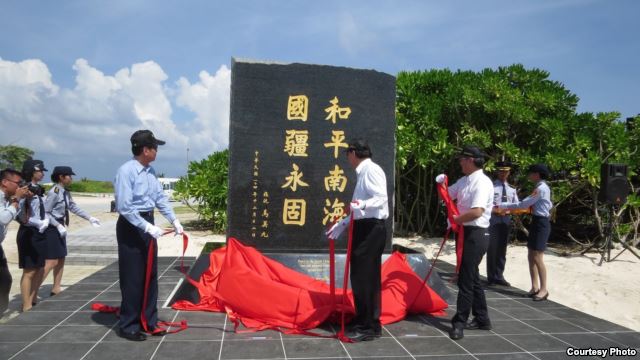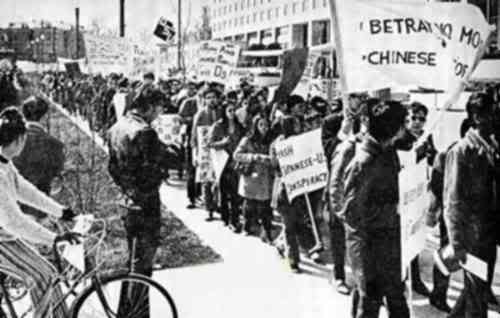by Brian Hioe
語言:
English
Photo Credit: Presidential Office
IT MAY BE ironic to note that Ma Ying-Jeou was once praised for peacekeeping policies in regards to disputed islands in the South China Seas with his South China Sea Peace Initiative and East China Sea Peace Initiative. In calling for conflicting territory claims in the South and East China Seas to be put aside by Taiwan, China, and Japan and for all parties to work towards cooperative development, the initiatives were seen as offering a possible solution to territorial conflict over disputed territories as the Senkaku/Diaoyu Islands.
Taiwan has a territorial claim to the Senkaku/Diaoyu Islands better known as disputed territory between China and Japan. Ironically, the Senkaku/Diaoyu Islands are actually geographically closer to Taiwan than to China or Japan. Of course, it is that Taiwan’s claim to the Senkaku/Diaoyu Islands is overshadowed by those of China and Japan, further complicated by the fact that Taiwan’s claim to the Senkaku/Diaoyu Islands is part of the the Republic of China government’s pretensions to rightful sovereignty to the whole of Chinese territory.
 Ma unveiling a monument during his visit. The inscruption reads “Peace in the South Seas, Eternally Secure the National Borders”. Photo credit: Ministry of the Interior
Ma unveiling a monument during his visit. The inscruption reads “Peace in the South Seas, Eternally Secure the National Borders”. Photo credit: Ministry of the Interior
Yet a recent visit by Taiwanese president Ma Ying-Jeou to disputed island of Itu Aba, also known as Taiping Island, has made waves because of the potential to incite territorial disputes over islands in the South China Seas. Itu Aba is the largest of the Spratly Islands chain. Though currently administered by Taiwan, with the existence of fortifications, military barracks, a hospital, radar and satellite facilities, and a temple on the island, the island is claimed by Taiwan, China, the Philippines, and Vietnam. The island is inhabited by two hundred individuals, none of which are civilians. Part of interest in claiming Itu Aba, as with other disputed South China Seas islands, would be because of the speculated existence of oil and mineral deposits in the South China Seas.
Ma’s visit has raised fears within Taiwan that a smooth transition to power from a KMT to DPP presidency will not occur during the four months of Ma’s presidential term he has, with sudden moves by Ma that disrupt Taiwan’s foreign relations as his Itu Aba visit or Ma’s November meeting in Singapore with Chinese president Xi Jinping. Ma has emphasized that he views himself as standing president of Taiwan and is in not favor of acting merely as head of a “caretaker” government.
Securing the ROC Legacy
FOR HIS PART, in his speech at Itu Aba, Ma reemphasized ROC territorial claims over the island. Ma further claimed that his visit was to raise the profile the island, so that it would not be downgraded to the legal status of a “rock” rather than an island, given that it is clear that the island is fit for human habitation. But Ma also stressed the importance of peace in the South China Seas. This is further irony, given the potential disruption to regional stability that Ma’s visit would pose. Again, Itu Aba is administered by Taiwan, but the timing of Ma’s visit threatens to raise tensions.
Certainly, Ma has seen condemnation for his visit, with no less than the US expressing disapproval of his actions through the American Institute in Taiwan. This would be ironic, given that America has in the past seen Ma as motivated by pragmatic, rather than ideological concerns, where issues as maintaining stable cross-straits relations with China is concerned. The DPP, on other hand, was at times seen as disruptive of cross-strait stability on the basis of its fixation on dangerous pro-independence ideology.
Yet it may be that Ma’s concerns are wholly ideological in nature at this point. As pointed out by many, sudden unexpected moves by Ma such as the Ma-Xi meeting may be driven by Ma’s desire to cement his legacy as a president on his way out of office. The historic nature of the Ma-Xi meeting, as the first meeting of PRC and ROC heads of state to occur since the Chinese Civil War, would certainly cement a historic place for Ma in Taiwanese history. But, perhaps more to the point, this also cements a historic place for Ma within KMT party history, as the first KMT president to make a breakthrough in the deadlock of relations between Taiwan and China by accomplishing a meeting with Xi Jinping.
Most foreign commentators have to date failed to take into account the KMT’s internal party ideology as a factor which explains much of the KMT’s actions that appear illogical from the standpoint of pragmatic politics. KMT party ideology accords a special place to outlying islands which the ROC has a claim to as an integral part of the ROC’s inviolable territory.
For example, the Protect the Diaoyu Islands Movement (保釣運動) was organized among overseas, Chinese-identified Taiwanese studying in the US from 1970 to 1972 to return sovereignty of the Senkaku/Diaoyu to ROC hands. Overseas Taiwanese allowed to travel abroad at that point in time largely had ties to the KMT which would allow them such privilege. The Protect the Diaoyu Islands Movement would later morph into a movement with a more general call for reunification between Taiwan and China and spread to Taiwan itself, with participants from National Taiwan University, National Taiwan Normal University, and National Chengchi University.
 Protect the Diaoyu Islands Movement demonstration in front of the United Nations Headquarters in New York City in January 1971
Protect the Diaoyu Islands Movement demonstration in front of the United Nations Headquarters in New York City in January 1971
Ma Ying-Jeou, then studying at Harvard as a graduate student, was an enthusiastic participant in the movement. Ma’s doctoral dissertation, “Trouble Over Oily Waters: Legal Problems of Seabed Boundaries and Foreign Investments in the East China Sea”, was on this specific issue of disputed island territories. It may be no surprise, then, that the ROC’s sovereignty claims over South and East China Seas islands has historically been an issue near and dear to Ma Ying-Jeou’s heart.
Dangerous Ideological Motivations?
SO THEN MIGHT Ma’s motivations with his Itu Aba visit be wholly ideological in nature. based on the timing of his recent visit to Itu Aba. Yet we might even Chen Shui-Bian actually also visited the island in 2008 in order to reiterate territorial claims over the island. But one may also speculate that Ma’s intentions are to sabotage the foreign policy of Tsai Ing-Wen, the incoming DPP president. Tsai’s “New Southwards Policy” calls for building closer ties between Taiwan, the Philippines, and Vietnam, which are both countries that also claim Itu Aba. Tsai, however, has also declared that she plans to maintain the ROC’s current territorial claims, including claims to the Senkaku/Diaoyu Islands.
But will we see more unexpected moves by Ma that threaten to shake regional stability in the four months left in his term? One worries that Ma’s Itu Aba visit is only the first of future moves aimed at shaking up Taiwanese politics in the time left he has in office and that Ma is motivated by only internal KMT ideology above all else. It may be Ma, as a lame duck president, does not wish to go gently into the good night.


 Ma unveiling a monument during his visit. The inscruption reads “Peace in the South Seas, Eternally Secure the National Borders”. Photo credit: Ministry of the Interior
Ma unveiling a monument during his visit. The inscruption reads “Peace in the South Seas, Eternally Secure the National Borders”. Photo credit: Ministry of the Interior Protect the Diaoyu Islands Movement demonstration in front of the United Nations Headquarters in New York City in January 1971
Protect the Diaoyu Islands Movement demonstration in front of the United Nations Headquarters in New York City in January 1971